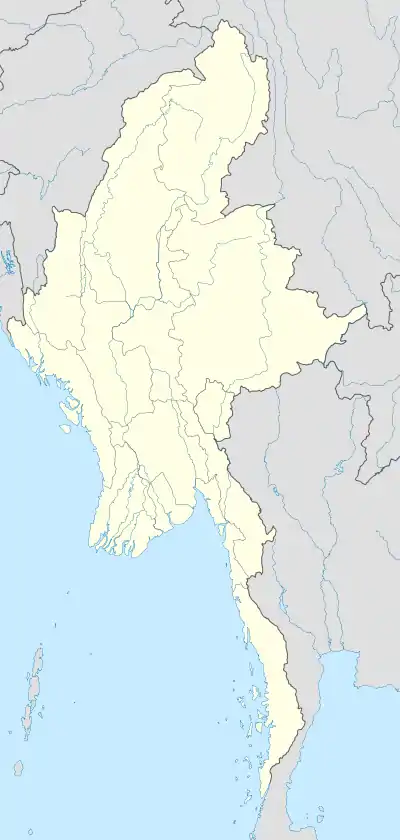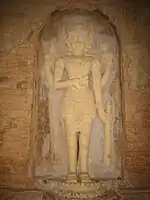Nathlaung Kyaung Temple
The Nathlaung Kyaung Temple (Sanskrit: नाथ्लौंग क्यौंग, Burmese: နတ်လှောင်ကျောင်း [naʔl̥àʊɰ̃ tɕáʊɰ̃]; lit. 'shrine confining the spirits') is a Hindu temple dedicated to Vishnu. The temple is located inside the city walls of old Bagan, Burma (Coordinates: 21.168965° N, 94.862738° E).[1]
| Nathlaung Kyaung Temple | |
|---|---|
.jpg.webp) Nathlaung Kyaung Hindu Temple. Archaeological evidence suggests the temple complex once had a much larger structure and galleries, but now all that is gone, and only the core square temple is left. | |
| Religion | |
| Affiliation | Hinduism |
| Deity | Vishnu |
| Location | |
| Location | Bagan |
| State | Mandalay Region |
| Country | Burma |
 Shown within Myanmar | |
| Geographic coordinates | 21.168965°N 94.862738°E |
| Architecture | |
| Date established | 10th-11th century |
Nathlaung Kyaung Temple is to the west of the Thatbyinnyu Temple, and it is the only remaining Hindu temple in Bagan. Nat-Hlaung Kyaung temple is one of the oldest temples in Bagan, and was built in the 11th century, during the reign of King Anawratha. Some historians believe the temple was built in the 10th century, during the reign of King Nyaung-u Sawrahan (also known as Taungthugyi). The temple was originally built for Hindu Burmese Indians of the 11th century, including merchants and Brahmins in the service of the king. Many structures of the original temple have disappeared, although the main hall remains. Originally, the temple contained statues of the incarnations of Vishnu; however, today, only seven remain. The brick temple was isolated and unrepaired for many years, damaged by earthquakes.
The temple is set on a square template with steep-rising upper terraces. It may have been built by Indian artisans brought into Bagan (Pagan), during the 10th century AD, to work on it and other temples. As the oldest temple in Bagan, its style influenced and inspired the numerous other Buddhist structures that followed.[2] Another legend states that the temple was built to store all the nat from other temples, so that Buddhism could get established in Bagan Kingdom.
See also
- Thatbyinnyu Temple – east of Nathlaung Kyaung temple
- Ananda Temple – 0.4 miles from Nathlaung Kyaung temple
- Bupaya Pagoda – 0.6 miles from Nathlaung Kyaung temple
- Dhammayangyi Temple – 0.8 miles from Nathlaung Kyaung temple
- Hinduism in Southeast Asia
- Hindu temple
Gallery
 Nathlaung Kyaung Temple
Nathlaung Kyaung Temple Images of Hindu Gods at the entrance
Images of Hindu Gods at the entrance One of seven Vishnu statues in the Nat-Hlaung Kyaung temple, Bagan, Myanmar. Originally there were 10 idols dedicated to Vishnu; three were removed, one is in Berlin Dahlem Museum.
One of seven Vishnu statues in the Nat-Hlaung Kyaung temple, Bagan, Myanmar. Originally there were 10 idols dedicated to Vishnu; three were removed, one is in Berlin Dahlem Museum. Stone Inscription at Nathlaung Kyaung Temple written in Burmese
Stone Inscription at Nathlaung Kyaung Temple written in Burmese
References
- Pierre Pichard (1994), Inventory of Monuments at Pagan, vol. 6, Monuments [numbered] 1440-1736, Kiscadale EFEO UNESCO, Paris, see Monument 1600
- Paul Strachan (1990), Pagan: Art & Architecture of Old Burma, 2nd edition, Kiscadale Publications, ISBN 978-1870838856
External links
- Nathlaung Kyaung Temple (built c. 931), with images and text by Robert Fiala of Concordia University, Nebraska, USA
- Pictorial Guide to Pagan. Rangoon: Ministry of Culture. 1975 [1955].
- Location map of Nat Hlaung Kyaung Temple Go Historic Maps